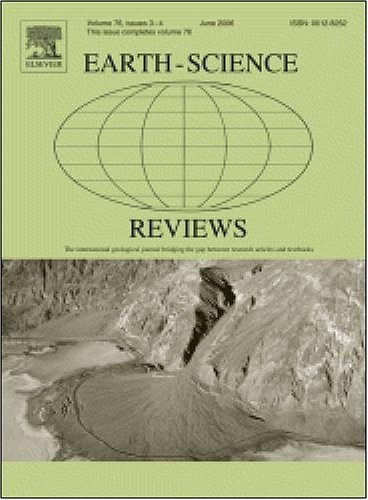泥盆纪晚期海洋介形动物群的灭绝事件。第二部分:汉根堡事件
IF 10
1区 地球科学
Q1 GEOSCIENCES, MULTIDISCIPLINARY
引用次数: 0
摘要
这项工作是评估两次晚泥盆纪生物危机(Kellwasser和Hangenberg事件)中介形虫群落变化的两部分研究的第二部分。汉根堡事件是法门纪和泥盆纪晚期最严重的灭绝事件。它有时被认为相当于frasian - famenian过渡时期的Kellwasser事件,后者是显生宙五大物种大灭绝之一。为了讨论汉根堡事件对海洋介形类动物群的影响,我们收集了文献中所有年代准确的数据。本研究表明,这一事件对介形虫多样性的影响主要在低分类水平(种和属)。近岸介形类受影响最大,图林根深海动物群也受影响较大。当考虑到该事件的地理模式时,来自南瓦利斯坎边缘(法国Montagne Noire)的介形虫似乎比其他地区受到的影响要小,因此可能代表了一个避难区。动物群的恢复当然受到了古环境变化的限制,特别是那些与早期图尔奈世、石炭纪最底层的海侵有关的环境变化。它可能增加了浅海环境中栖息地的大小和可用性,在事件发生后,允许来自bairdididae, Bairdiocyprididae和Paraparchitidae科的介形类的重要多样化,以及近岸地区之间更大的连通性,从而导致全球地方性减少。它也可能引发了深海生物类群的上坡迁移,正如在南瓦利斯坎边缘的事件后组合所记录的那样。对远洋分类群的影响在不同的地点和环境中变化较大,但它们通常是构成事件组合的唯一分类群之一,特别是在东南Laurussian边缘的深海环境中。在全球范围内,近岸介形类多样性受Hangenberg事件的影响略小于Kellwasser事件,但前者对深底栖动物的影响更为显著。最后,Kellwasser事件引发了介形虫动物群更剧烈的灭绝,而Hangenberg事件似乎对动物组成的更重要变化负责,特别是在近岸环境中。本文章由计算机程序翻译,如有差异,请以英文原文为准。
Marine ostracod faunas through the Late Devonian extinction events. Part II: the Hangenberg event
This work is the second part of a two-part study evaluating the changes in ostracod communities throughout the two Late Devonian biological crises (Kellwasser and Hangenberg events). The Hangenberg event was the most intense extinction of the Famennian, Late Devonian. It is sometimes considered as equivalent to the Kellwasser event at the Frasnian-Famennian transition, which is one of the Big Five mass extinctions of the Phanerozoic. In order to discuss the effects of the Hangenberg event on marine ostracod faunas, all well-dated data from the literature have been gathered. We here show that this event mostly affected the ostracod diversity at low taxonomic levels (species and genera). Nearshore ostracods were more affected than others but Thuringian deep-sea faunas were also greatly touched. When considering the geographic pattern of the event, ostracods from the Southern Variscan margin (Montagne Noire, France) appear to have been less affected than others, thus possibly representing a refuge zone.
The faunal recovery was certainly constrained by changes in palaeoenvironmental settings, in particular those associated with the transgression occurring during the early Tournaisian, lowermost Carboniferous. It may have increased the habitat size and availability in neritic environments, allowing an important diversification of ostracods from the Bairdiidae, Bairdiocyprididae and Paraparchitidae families in the event aftermath, as well as a greater connectivity between nearshore areas leading to a global reduction in endemism. It may also have triggered the migration of bathyal taxa upslope, as recorded in post-event assemblages on the Southern Variscan margin. The effects on pelagic taxa are more variable across localities and environments but they are often among the only taxa composing event assemblages, particularly in deep-sea settings of the Southeastern Laurussian margin.
At a global scale, nearshore ostracod diversity was slightly less affected by the Hangenberg event than by the Kellwasser one, but the former has more significantly influenced deep benthic faunas. Finally, the Kellwasser event triggered a more intense extinction within ostracod faunas while the Hangenberg one seems responsible for a more important change in faunal composition, particularly within nearshore environments.
求助全文
通过发布文献求助,成功后即可免费获取论文全文。
去求助
来源期刊

Earth-Science Reviews
地学-地球科学综合
CiteScore
21.70
自引率
5.80%
发文量
294
审稿时长
15.1 weeks
期刊介绍:
Covering a much wider field than the usual specialist journals, Earth Science Reviews publishes review articles dealing with all aspects of Earth Sciences, and is an important vehicle for allowing readers to see their particular interest related to the Earth Sciences as a whole.
 求助内容:
求助内容: 应助结果提醒方式:
应助结果提醒方式:


